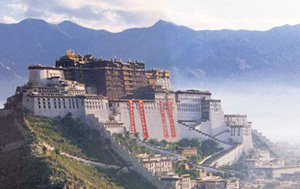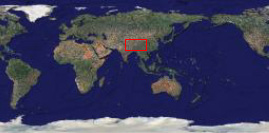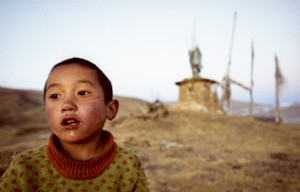SUMMARY: Tibet is a land only for the rugged and brave. At 18,000 feet, Tibet is considered the "rooftop of the world." Few plants can grow at this altitude, so vegetarians beware! Tibetan diets consist of yak milk, yak yogurt, yak butter and yak meat. Traveling to Tibet means living like a Tibetan—living in tents, eating yak products, hitching rides. Tibetans welcome foreigners into their tents, which are a definite relief from the chilly weather. Foreigners can expect to be constantly short of breath, and will probably experience altitude sickness, even if they don't climb Mount Everest, which is on the border of Tibet and Nepal. Most Tibetans hold a great faith and respect in their spiritual leader, the Dalai Lama, who is currently in exile in India. Tibet has always had an independent spirit, and it views the Dalai Lama as a symbol of the independence they hope to regain. Today, China watches its province closely for any signs of political insurrections.
Tibet is a land only for the rugged and brave. At 18,000 feet, Tibet is considered the "rooftop of the world." Few plants can grow at this altitude, so vegetarians beware! Tibetan diets consist of yak milk, yak yogurt, yak butter and yak meat. Traveling to Tibet means living like a Tibetan—living in tents, eating yak products, hitching rides. Tibetans welcome foreigners into their tents, which are a definite relief from the chilly weather. Foreigners can expect to be constantly short of breath, and will probably experience altitude sickness, even if they don't climb Mount Everest, which is on the border of Tibet and Nepal. Most Tibetans hold a great faith and respect in their spiritual leader, the Dalai Lama, who is currently in exile in India. Tibet has always had an independent spirit, and it views the Dalai Lama as a symbol of the independence they hope to regain. Today, China watches its province closely for any signs of political insurrections.
PROFILE: Area: 2.5 million square kilometers Capital city: Lhasa People: 44% Tibetan, 56% Mandarin Chinese (mostly Kham and Amdo) Language: Chinese (official), Tibetan Religion: Tibetan Buddhism and Bon Government: Communist (government in exile: Parliamentary)
MONEY & COSTS: Currency: Renminbi Exchange Rate: US$1 = 8.28 Relative cost: Budget Meal: US$ 1-2 Budget Room: US$ 3-5
It's possible to get by for US$8-12 a day. In Lhasa and other major cities, prices tend to be on the high end. Outside of the cities, it can be much cheaper.
TRANSPORTATION: Traveling in Tibet can be difficult. Bring plenty of water to combat altitude sickness. Four-wheel drive vehicles are often very expensive to hire, and buses tend to be unreliable. For the most part, it's easiest to live like nomads, which means hitching rides on big cargo trucks and gasoline tankers. There are no paved roads in Tibet, and landslides often make the roads impassable. The only way to get to Tibet in winter is by trekking.
RELIGION:
With the support of the Dalai Lama, Tibetan Buddhism is closely tied to the desire for political independence. Most Tibetans have a picture or pin of the Dalai Lama. Tibetan Buddhism involves good and bad Karma, and the Tibetans are constantly trying to work off the bad Karma. They might count prayer beads or journey to the holy city of Lhasa to rid themselves of the bad karma. The Bon religion, which is a form of Shamanism (a cult where shamans, or magician-priests, communicate with gods, demons and spirits), was practiced by the ancient Tibetans, and still has a small following today.
CALL TO MISSIONARIES: To reach the Tibetan community, you need to be prepared to live a nomadic lifestyle, perhaps stranded with one family for weeks. Tibetans are very friendly, and will readily welcome you into their homes, warming you in their tents and sharing their yak products. Tibetans are very religious people, and tend to be receptive to the Gospel message. The area seems completely void of any Christian influence. There are no active churches, although there may be some underground churches. The Chinese government tends to be restrictive of Christian missionaries, but in Tibet they are much more concerned with Westerners who might try to instigate an uprising. As a unreached place which rarely hears the Gospel, Tibet is certainly a region in need of dedicated missionaries and fervent prayers.
